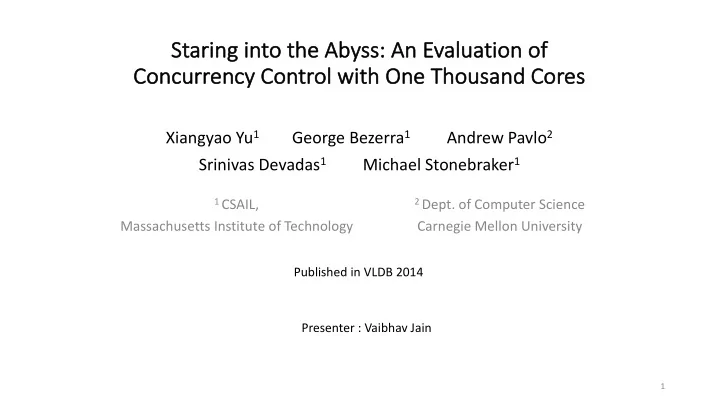

St Staring g into the Abyss: ss: An Evaluation of Co Concurrency Co y Control wi with O One T Thousand Co Cores Xiangyao Yu 1 George Bezerra 1 Andrew Pavlo 2 Srinivas Devadas 1 Michael Stonebraker 1 1 CSAIL, 2 Dept. of Computer Science Massachusetts Institute of Technology Carnegie Mellon University Published in VLDB 2014 Presenter : Vaibhav Jain 1
Motivation(1) Ø The era of single-core CPU speed-up is over. Ø Number of cores on a chip is increasing exponentially § Increase computation power by thread level parallelism § 1000-core chips are near… Xeon Phi (up to 61 cores) Tilera (up to 100 cores) 2
Motivation(2) Ø Is the DBMS ready to be scaled ? § Most DBMSs still focus on single-threaded performance § Existing works on multi-cores focus on small core count 3
Objective • To evaluate transaction processing at 1000 cores. • Focus on one scalability challenge : Concurrency control. • Discuss the bottlenecks and improvements needed. 4
Implementation • Concurrency Control Schemes • DBMS TestBed 5
Concurrency Control Schemes CC Scheme Description DL_DETECT 2PL with deadlock detection Two–Phase Locking (2PL) NO_WAIT 2PL with non-waiting deadlock prevention WAIT_DIE 2PL with wait-and-die deadlock prevention TIMESTAMP Basic T/O algorithm Timestamp Ordering (T/O) MVCC Multi-version T/O OCC Optimistic concurrency control Partitioning HSTORE T/O with partition-level locking 6
Two-Phase Locking (1) 7
Two-Phase Locking (2) Ø Lock conflict § DL_DETECT: always wait. deadlock detection § NO_WAIT: always abort. deadlock prevention § WAIT_DIE: wait if older, otherwise abort Ø Example systems § Ingres, Informix, IBM DB2, MS SQL Server, MySQL (InnoDB) 8
Concurrency Control Schemes CC Scheme Description DL_DETECT 2PL with deadlock detection Two–Phase NO_WAIT 2PL with non-waiting deadlock prevention Locking (2PL) WAIT_DIE 2PL with wait-and-die deadlock prevention TIMESTAMP Basic T/O algorithm Timestamp MVCC Multi-version T/O Ordering (T/O) OCC Optimistic concurrency control HSTORE T/O with partition-level locking Partitioning 9
Timestamp Ordering (T/O) (1) Each transaction has a unique timestamp indicating the serial order. 1. TIMESTAMP ( Basic Timestamp Ordering ) • R/W request rejected if tx timestamp < timestamp of last write. 2. MVCC (M ulti- V ersion C oncurrency C ontrol ) • Every write op creates a new timestamped version • For read op, DBMS decides which version it accesses. 10
Timestamp Ordering (T/O) (2) 3. OCC (O ptimistic C oncurrency C ontro l) • Private workspace of each transaction. • At commit time, if any overlap, tx is aborted and restarted. • Advantage : short contention period. Example systems Oracle, Postgres, MySQL (InnoDB), SAP HANA, MemSQL, MS Hekaton 11
Concurrency Control Schemes CC Scheme Description DL_DETECT 2PL with deadlock detection Two–Phase NO_WAIT 2PL with non-waiting deadlock prevention Locking (2PL) WAIT_DIE 2PL with wait-and-die deadlock prevention TIMESTAMP Basic T/O algorithm Timestamp Ordering (T/O) MVCC Multi-version T/O OCC Optimistic concurrency control HSTORE T/O with partition-level locking Partitioning 12
H-Store • Database divided into disjoint memory subsets called partitions. • Each partition protected by locks. • Tx acquires locks to all partitions it needs to access. • DBMS assigns it a timestamp and adds it to lock queues. 13
DBMS Test Bed (1) Graphite : CPU simulator , scales upto 1024 cores. • Application threads mapped to simulated core threads. • Simulated threads mapped to multiple processes on host machines. 14
DBMS Test Bed (2) • Implemented light-weight pthread based DBMS . • Allows to swap different concurrency schemes. • Ensures no other bottlenecks than concurrency control. • Reports transaction statistics. 15
General Optimizations 1. Memory Allocation: Custom malloc , resizable memory pool for each thread. 2. Lock Table: Instead of centralized lock table, per-tuple locks 3. Mutexes: Avoid mutex on critical path. - For 2PL, centralized deadlock detector - For t/o : allocating unique timestamps. 16
Scalable 2PL 1. Deadlock Detection - Making deadlock detector lock free by keeping local wait-for graph. - Thread searches for cycles in partial wait-for graph. 2. Lock Thrashing - Holding locks until commit => bottleneck in concurrent Txs. - Timeout threshold : abort Tx if wait time exceeds timeout. 17
Scalable T/O 1. Timestamp Allocation a) Batched atomic addition - Manager returns multiple timestamps for a request. b) CPU clocks - Read logical clock of core, concatenate with thread id. - requires synchronized clocks. c) Hardware counters - Physically located at center of CPU. 18
Ev Evaluation Read-Only Workload 19
Read Only Workload Ø 2PL schemes are scalable for read only benchmarks 20
Read Only Workload Ø 2PL schemes are scalable for read only benchmarks Ø Timestamp allocation limits scalability 21
Read Only Workload Ø 2PL schemes are scalable for read only benchmarks Ø Timestamp allocation limits scalability Ø Memory copy hurts performance 22
Write Intensive (medium contention) No_Wait, Wait_Die scales better than others. DL_Detect inhibited by lock thrashing. 23
Write Intensive (High contention) Ø Scaling stops at small core count(64) 24
Write Intensive (High contention) Ø Scaling stops at small core count(64) Ø NO_WAIT has good performance but falls due to thrashing. 25
Write Intensive (High contention) Ø Scaling stops at small core count (64) Ø NO_WAIT has good performance but falls due to thrashing. Ø OCC wins at 1000 cores as one Tx always commits. 26
More Analysis 1. Short Transactions => Low Lock contention Longer Transactions => Timestamp allocation not a bottleneck. 2. More read transactions => Better throughput. 3. Multi partition transactions => H-Store scheme performs bad. Partitioned workloads => H-Store best algorithm 27
Bottlenecks Summary Concurrency Waiting High Abort Timestamp Multi- Control (Thrashing) Rate Allocation partition DL_DETECT NO_WAIT WAIT_DIE TIMESTAMP MULTIVERSION OCC HSTORE 28
Summary All algorithms fail to scale as core increases. Ø Thrashing limits the scalability of 2PL algorithms Ø Timestamp allocation limits the scalability of T/O algorithms 29
Project Ideas • New concurrency control approaches to tackle scalability problem. • Hardware solutions to DBMS bottlenecks unsolvable in software side. • Hybrid approach : Switch b/w schemes depending on workload. 30
Questions 31
Thrashing A" B" C" D" transactions tuples x" y" z" u v" Locking Waiting 32
Recommend
More recommend